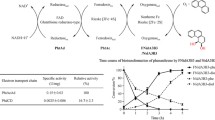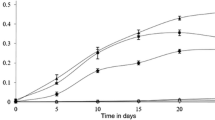Abstract
Rhodococcus opacus strain SAO101 was shown to degrade on various polycyclic aromatic hydrocarbons such as naphthalene, dibenzofuran (DF), and dibenzo-p-dioxin (DD). One of the unique traits of the strain SAO101 is its ability to oxidize DF compounds by lateral dioxygenation. To clone the lateral dioxygenase gene involved in compound degradation in strain SAO101, we identified a cosmid clone that oxidizes aromatic compounds by using SAO101 genomic DNA. Sequencing analysis revealed that isolated cosmid clone contained ring-hydroxylating dioxygenase genes (narAaAb) with homologies to indene dioxygenase genes of Rhodococcus strain I24 and naphthalene dioxygenase genes of Rhodococcus strain NCIMB12038. The NarAaAb-expressing Rhodococcus cells exhibited broad substrate specificity for bicyclic aromatic compounds and had high ability to degrade dibenzofuran and naphthalene. Metabolite analysis revealed that dihydrodiol compounds were detected as metabolites from dibenzofuran by the NarAaAb-expressing Rhodococcus strain, indicating that dibenzofuran was converted by lateral dioxygenase activity of NarA dioxygenase. Based on reverse transcriptase-polymerase chain reaction analysis, it was found that the narAaAb genes were cotranscribed and that their expression was induced in the presence of aromatic hydrocarbon compounds. It is likely that these genes are involved in the degradation pathways of a wide range of aromatic hydrocarbons by this strain. Strain SAO101 harbors three huge linear plasmids, pWK301 (1,100 kbp), pWK302 (1,000 kbp), and pWK303 (700 kbp), and the nar genes were found to be located on the pWK301 plasmid.





Similar content being viewed by others
References
Ausubel FM, Brent R, Kingston RE, Moore DD, Seidman JG, Smith JA, Struhl K (eds) (1990) Current protocols in molecular biology, Suppl. 11. unit 16.2. Wiley, New York
Becher D, Specht M, Hammer E, Francke W, Schauer F (2000) Cometabolic degradation of dibenzofuran by biphenyl-cultivated Ralstonia sp. strain SBUG 290. Appl Environ Microbiol 66:4528–4531
Beil S, Happe B, Timmis KN, Pieper DH (1997) Genetic and biochemical characterization of the broad spectrum chlorobenzene dioxygenase from Burkholderia sp. strain PS12—dechlorination of 1, 2, 4, 5-tetracjlorobenzene. Eur J Biochem 247:190–199
Bressler DC, Fedorak PM (2000) Bacterial metabolism of fluorene, dibenzofuran, dibenzothiophene, and carbazole. Can J Microbiol 46:397–409
Cerniglia CE, Morgan JC, Gibson DT (1979) Bacterial and fungal oxidation of dibenzofuran. Biochem J 180:175–185
Eaton RW, Chapman PJ (1995) Formation of indigo and related compounds from indole carboxylic acids by aromatic acid-degrading bacteria: chromogenic reactions for cloning genes encoding dioxygenases that act on aromatic acids. J Bacteriol 177:6983–6988
Eaton RW, Selifonova OV, Gedney RM (1998) Isopropylbenzene catabolic pathway in Pseudomonas putida RE204: nucleotide sequence analysis of the ipb operon and neighboring DNA from pRE4. Biodegradation 9:119–132
Ensley BD, Ratzkin BJ, Osslund TD, Simon MJ, Wackett LP, Gibson DT (1983) Expression of naphthalene oxidation genes in Escherichia coli results in the biosynthesis of indigo. Science 222:167–169
Evans GA, Lewis K, Rothenberg BE (1989) High efficiency vectors for cosmid microcloning and genomic analysis. Gene 79:9–20
Fortnagel P, Harms H, Wittich RM, Krohn S, Meyer H, Sinnwell V, Wilkes H, Francke W (1990) Metabolism of dibenzofuran by Pseudomonas sp. strain HH69 and the mixed culture HH27. Appl Environ Microbiol 56:1148–1156
Fukuda K, Nagata S, Taniguchi H (2002) Isolation and characterization of dibenzofuran-degrading bacteria. FEMS Microbiol Lett 208:179–185
Harms H, Wittich RM, Sinnwell V, Meyer H, Fortnagel P, Francke W (1990) Transformation of dibenzo-p-dioxin by Pseudomonas sp. strain HH69. Appl Environ Microbiol 56:1157–1159
Hart S, Koch KR, Woods DR (1992) Identification of indigo-related pigments produced by Escherichia coli containing a cloned Rhodococcus gene. J Gen Microbiol 138(Pt 1):211–216
Hiraishi A, Yonemitsu Y, Matsushita M, Shin K, Kuraishi H, Kawahara K (2002) Characterization of Porphyrobacter sanguineus sp. nov., an aerobic bacteriochlorophyll-containing bacterium capable of degrading biphenyl and dibenzofuran. Arch Microbiol 178:45–52
Iida T, Mukouzaka Y, Nakamura K, Kudo T (2002) Plasmid-borne genes code for an angular dioxygenase involved in dibenzofuran degradation by Terrabacter sp. strain YK3. Appl Environ Microbiol 68:3716–3723
Jornvall H, Persson B, Krook M, Atrian S, Gonzalez-Duarte R, Jeffery J, Ghosh D (1995) Short-chain dehydrogenases/reductases (SDR). Biochemistry 34:6003–6013
Kasuga K, Habe H, Chung JS, Yoshida T, Nojiri H, Yamane H, Omori T (2001) Isolation and characterization of the genes encoding a novel oxygenase component of an angular dioxygenase from the gram-positive dibenzofuran-degrader Terrabacter sp. strain DBF63. Biochem Biophys Res Commun 283:195–204
Kimura N, Urushigawa Y (2000) Metabolism of dibenzo-p-dioxin and chlorinated dibenzo-p-dioxin by a gram-positive bacterium, Rhodococcus opacus SAO101. J Biosci Bioeng 92:138–143
Kitagawa W, Kimura N, Kamagata Y (2004) A novel p-nitrophenol degradation gene cluster from a gram-positive bacterium, Rhodococcus opacus SAO101. J Bacteriol 186:4894–4902
Klecka GM, Gibson DT (1979) Metabolism of dibenzo[1,4]dioxan by a Pseudomonas species. Biochem J 180:639–645
Klecka GM, Gibson DT (1980) Metabolism of dibenzo-p-dioxin and chlorinated dibenzo-p-dioxin by a Beijerinckia species. Appl Environ Microbiol 39:288–296
Kulakov LA, Allen CC, Lipscomb DA, Larkin MJ (2000) Cloning and characterization of a novel cis-naphthalene dihydrodiol dehydrogenase gene (narB) from Rhodococcus sp. NCIMB12038. FEMS Microbiol Lett 182:327–331
Kulakov LA, Chen S, Allen CC, Larkin MJ (2005) Web-type evolution of rhodococcus gene clusters associated with utilization of naphthalene. Appl Environ Microbiol 71:1754–1764
Kurkela S, Lehvaslaiho H, Palva ET, Teeri TH (1988) Cloning, nucleotide sequence and characterization of genes encoding naphthalene dioxygenase of Pseudomonas putida strain NCIB9816. Gene 73:355–362
Larkin MJ, Allen CC, Kulakov LA, Lipscomb DA (1999) Purification and characterization of a novel naphthalene dioxygenase from Rhodococcus sp. strain NCIMB12038. J Bacteriol 181:6200–6204
Laurie AD, Lloyd-Jones G (1999) The phn genes of Burkholderia sp. strain RP007 constitute a divergent gene cluster for polycyclic aromatic hydrocarbon catabolism. J Bacteriol 181:531–540
Maruyama T, Ishikura M, Taki H, Shindo K, Kasai H, Haga M, Inomata Y, Misawa N (2005) Isolation and characterization of o-xylene oxygenase genes from Rhodococcus opacus TKN14. Appl Environ Microbiol 71:7705–7715
Monna L, Omori T, Kodama T (1993) Microbial degradation of dibenzofuran, fluorene, and dibenzo-p-dioxin by Staphylococcus auriculans DBF63. Appl Environ Microbiol 59:285–289
Nakashima N, Tamura T (2004) A novel system for expressing recombinant proteins over a wide temperature range from 4 to 35 °C. Biotechnol Bioeng 86(2):136–148, 20
Raschke H, Meier M, Burken JG, Hany R, Muller MD, Van Der Meer JR, Kohler HP (2001) Biotransformation of various substituted aromatic compounds to chiral dihydrodihydroxy derivatives. Appl Environ Microbiol 67:3333–3339
Sambrook J, Fritsch E, Maniatis T (1989) Molecular cloning: a laboratory manual, 2nd edn. Cold Spring Harbor, New York
Sato SI, Nam JW, Kasuga K, Nojiri H, Yamane H, Omori T (1997) Identification and characterization of genes encoding carbazole 1,9a-dioxygenase in Pseudomonas sp. strain CA10. J Bacteriol 179:4850–4858
Steinmetz M, Winoto A, Minard K, Hood L (1982) Clusters of genes encoding mouse transplantation antigens. Cell 28:489–498
Strubel V, Rast HG, Fietz W, Knackmuss HJ, Engesser KH (1989) Enrichment of dibenzofuran utilizing bacteria with high co-metabolic potential towards dibenzodioxin and other anellated aromatics. FEMS Microbiol Lett 49:233–238
Treadway SL, Yanagimachi KS, Lankenau E, Lessard PA, Stephanopoulos G, Sinskey AJ (1999) Isolation and characterization of indene bioconversion genes from Rhodococcus strain I24. Appl Microbiol Biotechnol 51:786–793
Wittich RM (1998) Degradation of dioxin-like compounds by microorganisms. Appl Microbiol Biotechnol 49:489–499
Yen KM, Karl MR (1992) Identification of a new gene, tmoF, in the Pseudomonas mendocina KR1 gene cluster encoding toluene-4-monooxygenase. J Bacteriol 174:7253–7261
Acknowledgements
We would like to thank Masao Fukuda and Hisashi Kudo for their help with the PFGE analysis. This research was supported by “Global Environment Research Fund” by the Ministry of Environment, Japan F-7.
Author information
Authors and Affiliations
Corresponding author
Rights and permissions
About this article
Cite this article
Kimura, N., Kitagawa, W., Mori, T. et al. Genetic and biochemical characterization of the dioxygenase involved in lateral dioxygenation of dibenzofuran from Rhodococcus opacus strain SAO101. Appl Microbiol Biotechnol 73, 474–484 (2006). https://doi.org/10.1007/s00253-006-0481-8
Received:
Revised:
Accepted:
Published:
Issue Date:
DOI: https://doi.org/10.1007/s00253-006-0481-8




